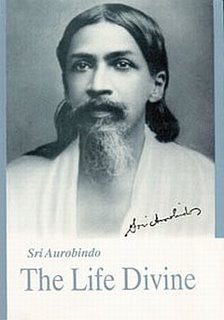 |
The Triple Status of Supermind
The unrolling of Space and Time: At the level of Mental Reality
The mental plane exercises greater flexibility in dealing with Space and Time than the physical and vital planes of consciousness. The Mother explains:
‘Space and time do not begin and end with the mental consciousness… They are forms of all cosmic existence: only, they vary on each level. Each world has its own space and time.
‘Thus the mental space and time do not tally with what we observe here in the material universe. In the mind-world we can move forward and backward at our own will and pleasure. The moment you think of a person you are with him; and no matter how near you may be to somebody, you can still be far away if your thoughts are occupied with someone else. The movement is immediate, so very free are the spatio-temporal conditions there. In the vital world, however, you have to use your will: there, too, distance is less rigid, but the movement is not immediate: the will has to be exercised.
‘The knowledge of different space-times can be of great practical value in Yoga’ (Collected Works of The Mother, Vol.3, pg 165).
|
|
It is important to appreciate that as one can mentally contact anyone instantaneously through the mechanism of thinking, time has no role between the initiation of the thought and its realisation. The Mother explains that it is only when the mind mingles with the vital that the phenomenon of time becomes relevant:
‘On the mental plane the notion of Time disappears almost totally. For example, you are in your mental consciousness, you think of someone or something or of a place, and immediately you are there. There is no need of any time between the thought and the realisation. It is only when the mind is mingled with the vital that the notion of time is introduced; and if they go down into the physical, before a mental conception can be realised a whole process is necessary. You do not have a direct mental action on matter. For instance, if you think of someone who lives in Calcutta, well, physically you have to take a plane and some hours must pass before you can be there; while mentally if you are here and think of someone in Calcutta, instantaneously you are there with him. Instantaneously, you see. But if you go out in the vital from your body and want to go somewhere, well, you have the feeling of moving, and of the time it takes you to reach the place you are going to. But it is incomparably fast in relation to the physical, to the time necessary to do things physically’ (Ibid, Vol.7, pg 219-220). Thus on one hand, a movement in the vital space propelled by a strong intelligent will is of much shorter duration than that of physical time and on the other hand is of much longer duration compared to the swift, albeit instantaneous movement in the mental space.
The Mother then explains the concept of Trikal-drishti, the giant point of Triple Time Vision which holds the past, present and future simultaneously, an experiential realisation at the heights of Consciousness:
‘Only right at the top of the ladder, when one reaches what could be called the centre of the universe, the centre and origin of the universe, everything is instantaneous. The past, present and future are all contained in a total and simultaneous consciousness, that is, what has always been and what will be are as though united in a single instant, a single beat of the universe, and it is only there that one goes out of Time and Space’ (Ibid, pg 220).
Date of Update:
24-Dec-15
- By Dr. Soumitra Basu
|

